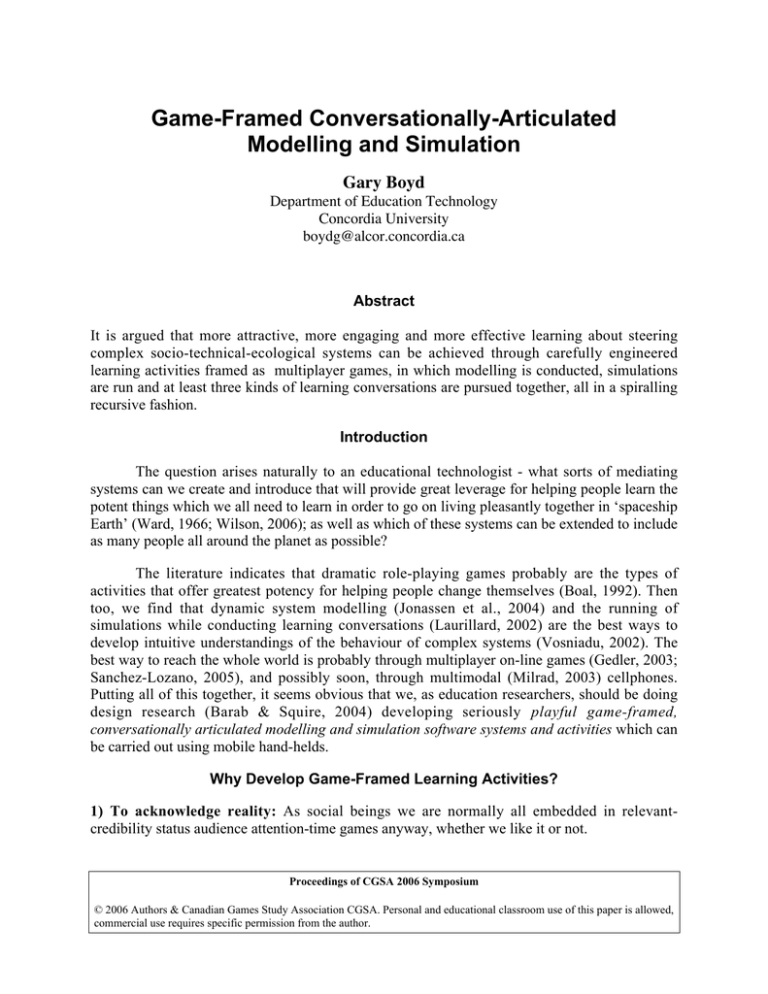Print version - Software @ SFU Library
advertisement

Game-Framed Conversationally-Articulated Modelling and Simulation Gary Boyd Department of Education Technology Concordia University boydg@alcor.concordia.ca Abstract It is argued that more attractive, more engaging and more effective learning about steering complex socio-technical-ecological systems can be achieved through carefully engineered learning activities framed as multiplayer games, in which modelling is conducted, simulations are run and at least three kinds of learning conversations are pursued together, all in a spiralling recursive fashion. Introduction The question arises naturally to an educational technologist - what sorts of mediating systems can we create and introduce that will provide great leverage for helping people learn the potent things which we all need to learn in order to go on living pleasantly together in ‘spaceship Earth’ (Ward, 1966; Wilson, 2006); as well as which of these systems can be extended to include as many people all around the planet as possible? The literature indicates that dramatic role-playing games probably are the types of activities that offer greatest potency for helping people change themselves (Boal, 1992). Then too, we find that dynamic system modelling (Jonassen et al., 2004) and the running of simulations while conducting learning conversations (Laurillard, 2002) are the best ways to develop intuitive understandings of the behaviour of complex systems (Vosniadu, 2002). The best way to reach the whole world is probably through multiplayer on-line games (Gedler, 2003; Sanchez-Lozano, 2005), and possibly soon, through multimodal (Milrad, 2003) cellphones. Putting all of this together, it seems obvious that we, as education researchers, should be doing design research (Barab & Squire, 2004) developing seriously playful game-framed, conversationally articulated modelling and simulation software systems and activities which can be carried out using mobile hand-helds. Why Develop Game-Framed Learning Activities? 1) To acknowledge reality: As social beings we are normally all embedded in relevantcredibility status audience attention-time games anyway, whether we like it or not. Proceedings of CGSA 2006 Symposium © 2006 Authors & Canadian Games Study Association CGSA. Personal and educational classroom use of this paper is allowed, commercial use requires specific permission from the author. As learners and as teachers, researchers and professional workers, we are actually all, almost all the time, implicitly involved in “Relevant-Credibility Status Knowledge Development” (RCSKD) games. We want what we do to attract favourable attention from audiences including higher credibility status people so as to raise our own status and increase our opportunities. RCSKD games are “reinforcing-feedback” type socio-cybernetic systems (see Figure 1). We have to be concerned with building and maintaining our reputations as trustworthy, sincere, knowledgeable, committed (Habermas, 1984) people, in order to get quality attention-time and various other resources including the helpful suggestions of others. As individual and group learners we are all usually embedded in such RCSKD games and leagues whether we choose to pay attention to this fact or not. Therefore I argue, why not acknowledge this explicitly by including designed RCSKD games as the frames for our learning conversations, and our modelling and simulation-based learning activities? . Figure 1. The Knowledge Development Credibility-status Game system 2) To teach important attitudes and commitments: Qvortrup (2006, pp.67-69) characterizes education in terms of two main dimensions: a) Rules versus Self-organisation; and b) Reality versus Virtuality. According to Qvortrup, all teaching can be placed on these dimensions. The distinction between rules and self-organisation corresponds to the distinction between games and play. Reality is 2 irreversible, but in order to learn people must make mistakes. So education must employ forgiving virtual simulation/game/play activities, as well as incorporate some real ones (such as final examinations). 3) For Seduction and the Satisfaction of scoring successes. Alfred North Whitehead pointed out that significant learning occurs by cycling through phases of romance, precision, and generalization (1949). Games provide romance and help develop precision (rules of play must be followed). And learning winning strategies amounts to generalisation learning. Multiplayer games offer more kinds of engagement and social rewards (Jensen & deCastell, 2002; Sanchez-Lozano, 2005) than other genres of gameplay. Why Conversational Articulation and Reflection throughout? 1. For elucidating Relevance. 2. For Precision and agreement on meanings: to reduce various types of uncertainty (Pask,1975; Laurillard, 2002); to reduce vagueness; to disambiguate terminology; to reduce uncertainty about the boundaries of concepts; to reduce uncertainty about logical possibilities and practical possibilities; and to seed Bayesian probability operations. 3. To introduce multiple perspectives via metaphors (diaphors, etc.). 4. To deal with cognitive fixity (inappropriate & obsolete cognitive habits). 5. To enable learners to grasp the complexity of what is going on at many levels, in their interactions with others and with the Learning Environment System. 6. Three basic kinds of Learning conversations have been identified and well characterized by Sheila Harri-Augstein and Laurie Thomas (1992). • Conversations about why we need to learn this stuff • Conversations about the particular stuff being done, experienced and learned • Conversations about how we can best regulate our learning (metacognitive skills). Why Socio-Cybersystemic Modelling? 1. Most organisationally, and indeed educationally, interesting systems are actually complex multi-level cyber-systems (Boyd, 1995). 2. To develop new knowledge by connecting situated practice with theoretical understanding of underlying generative causal processes (Bhaskar, 1989; Qvortrup, 2006). 3. In order to actually design simulations and games (Garris et al. 2002). Why ICT–Based Interactive Simulation-running? • ICT work spaces are accessible, flexible, and can be historically traced • They can help frame conjectures 3 • They are valuable for testing conjectures as to how stuff works (we learn from failures) • To understand how embedded people/avatars act out roles with one-another • To re-educate our intuitions • As a partial way to evaluate, knowledge and skill competencies • For flexibility How to Actually Design and Develop Game-framed Learning-activity Systems A wide range of process options is available for developing educational software. At one extreme we have “bricolage”, where you simply grab any tools and materials that are handy and try to cobble together by trial and error, something or other which will help some people learn better. At the other extreme is the engineering strategy. This involves establishing a clear agreed-upon statement of stakeholders’ aims and available resource budgets, followed by outcome analysis and needs analysis leading to detailed specifications of “competencies” or even behavioural objectives that learners must attain. Tests to use and determine if the target learning objective has been achieved are then constructed and validated. Instructional designs are created and developed based upon those learning theories which are appropriate for the desired outcomes and appropriate for the intended learner population. Then, all that is followed by the use of a fully formalized software engineering system, together with libraries of useful objects and `multimedia’ components. Even such disciplined well-engineered design must have formative evaluation with a representative sample of learners leading to revisions, as well as the inevitable software debugging before the software can be deployed. The `Lone-ranger’, or small team, bricolage approach is cheap, very flexible and can be a lot of fun, but does not guarantee any particular beneficial outcome, and tends to take forever. It is always undergoing improvements. The development process often becomes an end-in-itself for the bricoleurs – or they burn-out from overwork and give up. The rigorously fully engineered system production approach guarantees certain specific results, but is inflexible and very expensive. So it is best suited to developing high dollar-value knowledge and skills of an enduring character for stable fields with large populations - basic math, science and biology for youth everywhere (Bork 1986, 2007), or technical knowledge for legal and financial professionals. Clearly, certain in-between approaches which have some flexibility and some assurance of desired results at reasonable cost, are more beneficial and practical. Which ones are they? Experience and research is gradually telling us which approaches are more productive of important kinds of learning (Garris, Ablers & Driskill, 2002; Sanchez-Lozano, 2005). My guess based on everything I have looked at to date is one should follow a designbased research approach (Barab & Squire, 2004). That is, one should do evolutionary development with well-designed constraints (guidance and control) and much formative evaluation, as well as much reflective discourse. We must also use rapid prototyping with object-type components (not necessarily `learning objects’), as well as “flexible” or “malleable” formalized software engineering methods - for example, conceptual use-case diagrams in jMaps/Context Maps notation (Jaworski, 2006). 4 Twelve Essential Steps For Developing Game-Framed Learning-activity Systems 1) Specify aims richly, but not too precisely. Everything depends on the aims agreed upon for the venture, as well as who buys into them. This need not be a once and for all specification decision; participants can in time learn to appreciate and support aims which at first are not very appealing to them. 2) Specify the entry-level characteristics of participants. Their “MAXCACS” are particularly relevant, where M=Metaphor they use for the situation, A1= Aspirations for the outcomes, X=expectations of themselves and of others, C=entry level capabilities (skills, knowledge, empathy), A2=Anxieties. 3) Specify those Attitudes, Commitments, Knowledge and Skills, which are directly related to the espoused aims. Which Attitudes, Commitments, Knowledge and Skills, are directly related to the espoused aims, as opposed to ones that are related only indirectly or generally. Which skills have to be learned to a high (as opposed to medium or low) level of precision. Finally, which require a high (as opposed to medium or low) speed of execution? 4) Specify the Environments where learning is to take place (anywhere at all? or classrooms/labs or game gang rooms? 5) Specify the Media and Modes (sight, sound, motion, kinaesthetics, haptics) being used (standalone machines, mobiles, the Web, game engines). 6) Specify steering and control. Rules, turn-taking, kinds of feedback loops, conditions for termination, referees’ roles. Use a pay-off table with pay-off results display. 7) Specify Illustrata: Activities, necessary examples. 8) Specify a timeline and budget. 9) Mock up a rapid prototype and try it with sample participants. 10) Revise All Of The Above! 11) Freeze specs, productize, deliver. Future Research • Perhaps the most needed research relates to: Beneficiality of game-framed CMS for different institutional contexts • The value and use of cyberspace digital multiplayer enduring systems? (e.g. Second Life) • Game-framed mod-sim cost-effectiveness regarding alternatives such as case-based reasoning systems that are systemically contexted • Design-research to develop malleable, easily usable game-mod-sim-versation production and delivery engines 5 Conclusion Today, the combination of simulations and reflective learning conversations in game-framed digital space systems probably offers both the greatest educative leverage and potential coverage of any of the currently available educational media options. Acknowledgements This work has been partly supported by Canarie, SAGE and ENJEUX funding. 6 References Barab, S. & Squire, J. (2004) Design-Based Research: Putting a Stake in the Ground, The Journal of the Learning Sciences, 13(1), pp.1-14. Bhaskar, Roy (1989) A Realist Theory of Science. London, Verso. Boal, Augusto (1992) Games for Actors and Non-actors. London, Routledge. Bork, Alfred (1986) Advantages of computer-based learning, Journal of Structural Learning, 9, pp.63-76. Boyd, G (1995) Excavating the Emergent Levels of Cybersystemics, with a View to Concerted Progressive Action, SYSTEMICA 12, 1. Boyd, G (1993) Educating Symbiotic P-individuals through Multi-level Conversations, Systems Research, 10, pp.113-128. Garris, R., Ahlers, R., Driskell, J.E. (2002) Games Motivation and Learning: A research and Practice Model. Simulation & Gaming. 33(4) pp.441-467. Gredler, M. (2003). Games and Simulations a nod Their Relationship to Learning. In D. Jonassen (Ed.), Handbook of Research on Educational Communications and Technology Mahwah, N.J.: Lawrence Erlbaum Associates, Inc, pp. 1210. Habermas, J. (1984). The Theory of Communicative Action. Vol. I: Reason and the Rationalization of Society. (Trans. by Thomas McCarthy.) Boston: Beacon Press. Harri-Augstein, S. & Thomas, L. (1992) Learning Conversations. London, Routledge. Jenson, J. & de Castell, S. (2002) Serious Play: Challenges of Educational Game Design. Paper presented at AERA Annual Meeting in New Orleans, Louisiana April 1-5, 2002. Jaworski, W. M. (2006) http://www.gen-strategies.com/ Accessed October 2006. Jonassen, D.H., Strobel. J. Gottdenker, J. (2004) Modeling for meaningful learning. In R. Flodden & K. McEvett (Eds.) Technology for Meaningful Learning. NY. Teachers College Press Kirschner, P.A., Sweller, J., Clark, R.E. (2006) Why Minimal Guidance During Instruction Does Not Work: An Analysis of the Failure of Constructivist, Discovery, Problem-Based, Experiential, and Inquiry-Based Teaching, Educational Psychologist 4(2), pp.75-86. Laurillard, D. (2002). Rethinking university teaching: A framework for the effective use of educational technology (2nd Ed.). London: Routledge. Milrad, M. (2003) Mobile Learning Challenges, Perspectives and Reality. In Nyin, K. (Ed.) Mobile Learning; Essays on Philosophy Psychology and Education. Vienna, Passagen Verlag. Pask, Gordon (1975). Conversation cognition and learning: a cybernetic theory and methodology. Amsterdam , Elsevier. Qvortrup, Lars. (2006) Knowledge Education and Learning – E-Learning in the Knowledge Society. Frederiksberg Denmark, Samsfundslitteratur Press. Rapoport, A. (1974) Fights, Games, Debates . AnnArbor, Univ. Michigan Press. Sanchez-Lozano, J.C. (2005) MMOGS as an Alternative Model for Game-based Classroom Instruction and Training. Conference paper given at the Canadian Society for Training and Development, Toronto, Canada. Silvern, L. (1972) Systems Engineering Applied to Training. Houston, Gulf Publishing co. Vosniadu, S. (2002). Mental Models in Conceptual Development. In L.Magnani & N.J. Nersessian (Eds.) Model-based Reasoning; Science Technology and Values. NY. Kluwer. Ward, Barbara (1966) Spaceship Earth. N.Y. Columbia University Press. 7 Whitehead, A.N. (1949). The aims of education and other essays. New York: New American Library. Wilson, E.O. (2006) The Creation; An Appeal to Save Life on Earth. N.Y. W.W. Norton. Zyda, M. (2006) Educating the Next Generation of Game Developers. Computer. 39(6) pp.3034. 8


